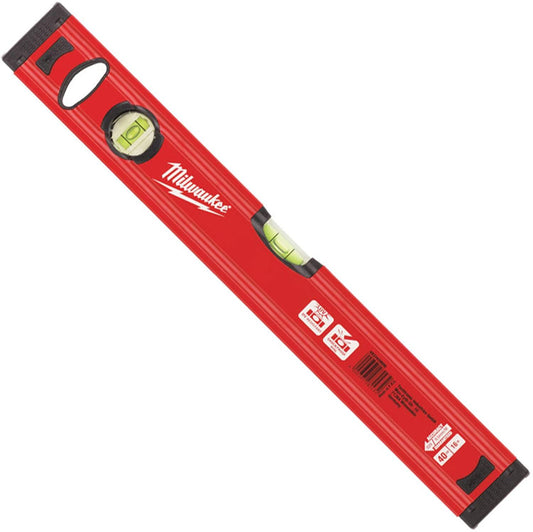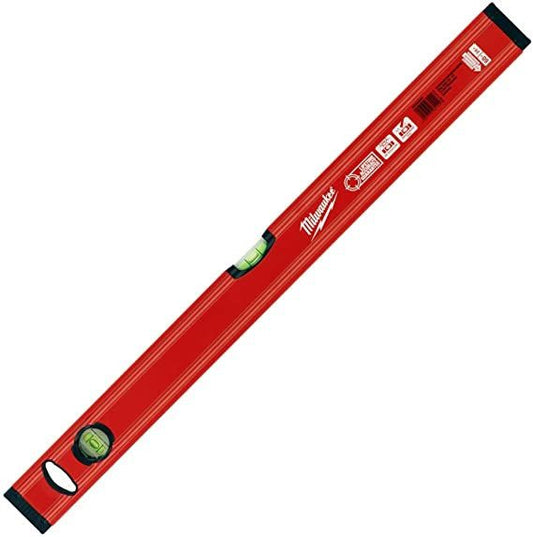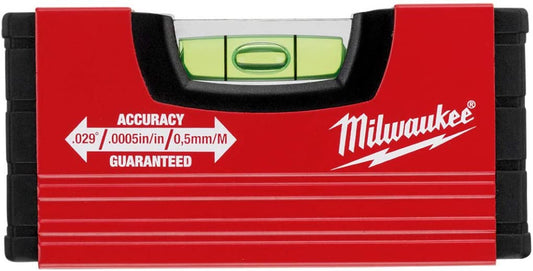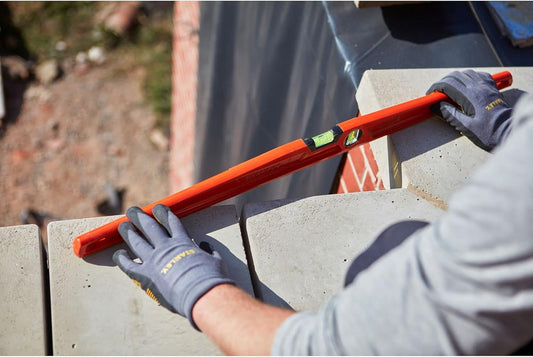-

 Sold out
Sold outSlim Level 20-120 cm Milwaukee
Vendor:MILWAUKEERegular price From 9,13€Regular priceUnit price per25,00€Sale price From 9,13€Sold out -
Milwaukee Pocket Level 10cm
Vendor:MILWAUKEERegular price 6,25€Regular priceUnit price per9,60€Sale price 6,25€Sale -
Rubilevel Magnet bubble level 60 cm
Vendor:RUBIRegular price 23,01€Regular priceUnit price per33,90€Sale price 23,01€Sale -
Magnetic Slim Level 40-60 cm Milwaukee
Vendor:MILWAUKEERegular price From 20,70€Regular priceUnit price per22,70€Sale price From 20,70€Sold out -
Rubilevel Magnet bubble level 50 cm
Vendor:RUBIRegular price 20,84€Regular priceUnit price per26,30€Sale price 20,84€Sale -
Rubilevel Magnet bubble level 80 cm
Vendor:RUBIRegular price 32,30€Regular priceUnit price per35,42€Sale price 32,30€Sale -
FatMax Pro Magnetic Tubular Level 200cm Stanley 0-43-679
Vendor:STANLEYRegular price 98,45€Regular priceUnit price per110,40€Sale price 98,45€Sale -
FatMax II Tubular Level 180cm Stanley 1-43-572
Vendor:STANLEYRegular price 77,33€Regular priceUnit price per87,66€Sale price 77,33€Sale -
FatMax II Tubular Level 120cm Stanley 1-43-548
Vendor:STANLEYRegular price 54,19€Regular priceUnit price per -
FatMax II Tubular Level 60cm Stanley 1-43-524
Vendor:STANLEYRegular price 31,33€Regular priceUnit price per41,34€Sale price 31,33€Sold out -

 Sold out
Sold outRubilevel Antishock Level 100cm Rubi
Vendor:RUBIRegular price 51,14€Regular priceUnit price per59,24€Sale price 51,14€Sold out -
Extra wide Tubular Level with Magnet 100cm Bellota 50107M100
Vendor:BELLOTARegular price 67,85€Regular priceUnit price per71,77€Sale price 67,85€Sale -
Extra magnetic Tubular Level 120cm Bellota 50107M120
Vendor:BELLOTARegular price 74,54€Regular priceUnit price per97,24€Sale price 74,54€Sale -
FatMax Digital Level 60cm Stanley 0-42-065
Vendor:STANLEYRegular price 83,04€Regular priceUnit price per -
FatMax Digital Level 40cm Stanley 0-42-063
Vendor:STANLEYRegular price 64,52€Regular priceUnit price per -
Extra wide Tubular Level with Magnet 80cm Bellota 50107M80
Vendor:BELLOTARegular price 55,99€Regular priceUnit price per61,72€Sale price 55,99€Sold out -
FatMax Pro Magnetic Tubular Level 60cm Stanley 0-43-625
Vendor:STANLEYRegular price 43,41€Regular priceUnit price per51,60€Sale price 43,41€Sale -
FatMax II Tubular Level 90cm Stanley 1-43-536
Vendor:STANLEYRegular price 48,19€Regular priceUnit price per55,20€Sale price 48,19€Sale -
FatMax Pro magnetic level 40cm Stanley 0-43-617
Vendor:STANLEYRegular price 38,40€Regular priceUnit price per38,40€Sale price 38,40€Sold out -
FatMax Xtreme Magnetic Tubular Level 90cm Stanley 0-43-637
Vendor:STANLEYRegular price 52,71€Regular priceUnit price per70,96€Sale price 52,71€Sale -
FatMax Pro Magnetic Tubular Level 120cm Stanley 0-43-649
Vendor:STANLEYRegular price 68,16€Regular priceUnit price per81,60€Sale price 68,16€Sale -
Malh Antichock Level 40cm Stanley 1-42-421
Vendor:STANLEYRegular price 42,98€Regular priceUnit price per48,36€Sale price 42,98€Sale -
Magnetic bubble level 45cm Expert E142302
Vendor:EXPERTRegular price 44,56€Regular priceUnit price per44,56€Sale price 44,56€
Leveler
Level meter
At Brikum, we know how crucial it is to have precise and reliable tools to make your DIY and construction projects easier. That's why we're introducing our range of levelers, designed to ensure every measurement is accurate and every line is perfectly aligned. With a leveler from our selection, you'll be able to tackle any leveling challenge, whether you're hanging pictures with professional precision or ensuring your surfaces are perfectly level before starting work.
The precision of a level like the ones you'll find at Brikum becomes your best ally, facilitating tasks that require a skilled eye and a steady hand. A level is not only an essential tool in any toolbox, but it's also the perfect companion for renovation, construction, and decoration projects, ensuring that the final result is impeccable and meets your expectations. Discover the level that will transform the way you work, giving you the confidence of knowing that every measurement is taken with the utmost precision.
With a Brikum leveler, you'll be equipped with the technology you need to complete your projects with the confidence that you're building on solid, perfectly aligned foundations. Welcome to the ultimate shopping experience for finding the leveler that will elevate the quality of your work to the next level.
How does a tile leveler work?
A tile leveler is an innovative tool designed to ensure even and perfectly aligned tile placement, guaranteeing professional finishes for any tiling project. This type of leveler is essential for preventing unevenness between tiles, which not only affects the aesthetics but also the functionality of tiled spaces.
The tile leveler works by placing it between the edges of adjacent tiles, just after they have been laid on the uncured tile adhesive. Depending on the leveling system, it may consist of wedges, clips, or a combination of both. Clips are inserted into the spaces between tiles, while wedges are used to apply the necessary pressure to level the tiles evenly.
Once the clips and wedges are in place, they are adjusted manually or with the help of a specific tile leveling tool. This adjustment applies even pressure to the edges of the tiles, pushing them down or pushing them together laterally until they are all level. This process not only ensures a completely flat final surface but also helps maintain a consistent joint width between each tile, contributing to the overall aesthetics of the job.
After the adhesive has completely dried and cured, the protruding parts of the tile leveler are removed. Depending on the type of leveler, this may involve breaking the clip tabs at the base level or simply removing the wedges. This final step leaves a perfectly level tile surface, ready for grouting.
Using a tile leveler greatly facilitates the tile installation process, allowing professionals and DIYers to achieve flawless results with less effort and in less time. In addition to improving the quality of the finish, the tile leveler reduces the risk of costly mistakes and increases the durability of the installation by preventing problems resulting from poor leveling, such as cracks in the grout or in the tiles themselves.
What is used to level the ground?
To level the floor, a floor leveler is used, a solution specifically designed to correct unevenness and ensure a flat and even surface. This product is essential in preparing floors before installing coverings such as tiles, laminate, parquet, or even carpet, ensuring a perfect and long-lasting finish.
Floor levelers come in the form of a mixture that can be cement-based or resin-based, depending on the type of application and the specific needs of the project. The choice between one or the other will depend on factors such as the magnitude of the unevenness to be corrected, the type of floor to be applied, and the type of final coating to be installed over it.
The leveling process begins with proper preparation of the floor, which must be clean, dry, and free of any residue that could affect the adhesion of the floor leveler. The leveler mix is then prepared according to the manufacturer's instructions, which generally involves adding water to the powder mix until a liquid but thick consistency is achieved.
Once prepared, the mixture is poured onto the floor, spreading it with a trowel or toothed rake to ensure even coverage. The product's self-leveling nature allows it to spread evenly, filling in depressions and creating a smooth, level surface. In some cases, it may be necessary to apply several coats to achieve the desired level, especially if the unevenness is significant.
The floor leveler dries and sets over a period of time that varies depending on the product, creating a solid, level base on which the final coating can be installed without fear of future problems such as cracks, warping, or uneven surfaces.
Using a floor leveler is a crucial step in preparing any flooring project, as it ensures an ideal base, which is critical to the success and longevity of any flooring installation. This step not only improves the aesthetics and functionality of the space but also contributes to the durability and quality of the overall project.
How to measure the water level?
To accurately and effectively measure water levels, a device known as a water level gauge is used. This device is essential in a variety of applications, from construction and agriculture to landscaping projects and pool maintenance. The water level gauge offers a simple yet effective way to determine height differences and ensure proper leveling of surfaces or compliance with specifications in water storage and distribution.
The basic principle behind the water leveler is the law of communicating vessels, which states that water will reach the same level in connected pipes, regardless of their shape or size, as long as they are connected and there are no significant pressure differences. A water leveler typically consists of a long, transparent tube filled with water or a colored solution to improve visibility.
The use of a water leveler is particularly useful in large areas or when high precision is required without the need for electronic or complex tools. It is an economical and efficient solution for ensuring proper drainage, leveling floors and foundations, or even for installing irrigation systems in agriculture.
Although the concept behind the water level gauge is simple, its practical application requires some skill to handle the tube correctly and take accurate readings. However, with a little practice, the water level gauge becomes an indispensable tool for any project requiring accurate water level measurement.







































